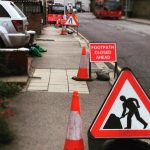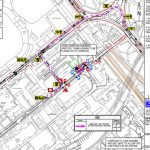The Importance of a Traffic and Pedestrian Management Plan for a Safer Community
The Importance of a Traffic and Pedestrian Management Plan for a Safer Community
As a community, our safety should always be a top priority. One aspect that often gets overlooked is the importance of having a traffic and pedestrian management plan in place. Whether it's a bustling city centre, a residential neighbourhood, or a school zone, ensuring the smooth flow of traffic and the safety of pedestrians is essential.
A well-designed traffic and pedestrian management plan helps reduce the risk of accidents, alleviates congestion, and improves overall transportation efficiency. This plan involves analysing traffic patterns, identifying high-risk areas, implementing appropriate signage and signalling systems, and establishing designated pedestrian zones.
By incorporating strategies such as traffic calming measures, enhanced crosswalks, and clear road markings, communities can create a safer environment for everyone. Moreover, a well-implemented plan also takes into consideration the needs of vulnerable road users, such as children, the elderly, and people with disabilities.
In this article, we will delve into the importance of a traffic and pedestrian management plan and how it benefits our community's safety. We will explore the key components of an effective plan and highlight successful examples from around the world.
Understanding traffic and pedestrian management
To truly appreciate the importance of a traffic and pedestrian management plan, it's crucial to understand its purpose and objectives. Traffic and pedestrian management refers to the strategies and measures put in place to optimise the movement of vehicles and ensure the safety of pedestrians in a given area. It encompasses a wide range of factors, including traffic flow, road infrastructure, signage, signalling systems, and the behaviour of road users.
The primary goal of traffic and pedestrian management is to create a safe, efficient, and sustainable transportation system. By implementing effective management strategies, communities can minimise the risk of accidents, reduce congestion, and enhance overall mobility. This not only improves the quality of life for residents but also attracts businesses and promotes economic growth.
The benefits of a traffic and pedestrian management plan
The benefits of implementing a comprehensive traffic and pedestrian management plans are numerous. Let's explore some of the key advantages that such a plan can bring to our community:
- Enhanced Safety
One of the most significant benefits of a traffic and pedestrian management plan is the improved safety it provides. By implementing measures such as traffic calming techniques, better signage, and designated pedestrian zones, the risk of accidents can be significantly reduced. This is particularly important for vulnerable road users, such as children, the elderly, and people with disabilities, who are more susceptible to accidents and injuries.
- Reduced Congestion
Congestion not only leads to frustration and delays but also increases the likelihood of accidents. By implementing an effective traffic and pedestrian management plan, communities can alleviate congestion by optimizing traffic flow and reducing bottlenecks. This not only improves the efficiency of transportation but also reduces fuel consumption and air pollution.
- Improved Mobility
A well-designed traffic and pedestrian management plan enhances the mobility of all road users. By implementing strategies such as synchronised traffic signals, efficient road design, and improved pedestrian infrastructure, communities can ensure a smoother flow of traffic and provide safer and more convenient options for pedestrians, cyclists, and public transport users.
- Enhanced Livability
A well-managed transportation system contributes to the overall livability of a community. By implementing measures that prioritise the safety and convenience of residents, such as traffic calming techniques and enhanced pedestrian infrastructure, communities can create a more pleasant and attractive living environment. This, in turn, improves the quality of life for residents and enhances community pride.
Statistics on traffic accidents and pedestrian incidents
Before diving into the key components of an effective traffic and pedestrian management plan, it's important to understand the severity of the issue we are trying to address. Traffic accidents and pedestrian incidents are a significant public safety concern, with far-reaching consequences. Let's take a look at some statistics to highlight the urgency of implementing a comprehensive management plan:
- According to the World Health Organization (WHO), approximately 1.35 million people die each year as a result of road traffic accidents, making it one of the leading causes of death worldwide.
- Pedestrians account for a significant portion of road traffic fatalities. In 2019, the WHO reported that pedestrians constituted 26% of all road traffic deaths globally.
- Vulnerable road users, such as pedestrians and cyclists, are particularly at risk. In the United States, for example, pedestrians and cyclists account for approximately 20% of all traffic-related fatalities.
These statistics highlight the urgent need for communities to prioritise the implementation of a traffic and pedestrian management plan to reduce the risk of accidents and protect vulnerable road users.
Components of an effective traffic and pedestrian management plan
To develop an effective traffic and pedestrian management plan, it's essential to understand its key components. While the specific components may vary depending on the characteristics and needs of a particular community, here are some fundamental elements that should be considered:
- Traffic Analysis and Data Collection
The first step in developing a successful plan is to conduct a thorough traffic analysis. This involves collecting data on traffic volume, speed, and patterns. By understanding the existing traffic conditions, communities can identify high-risk areas and develop targeted strategies to address them.
- Identification of High-Risk Areas
Based on the data collected, communities can identify high-risk areas where accidents are more likely to occur. This may include intersections with a high number of collisions, areas with heavy pedestrian traffic, or locations with poor visibility. By focusing on these areas, communities can implement measures to reduce the risk of accidents and improve overall safety.
- Traffic Calming Measures
Traffic calming measures are designed to slow down the speed of vehicles and create a safer environment for pedestrians. This may involve implementing speed bumps, roundabouts, or raised crosswalks to encourage drivers to reduce their speed. By reducing vehicle speeds, communities can significantly reduce the severity of accidents and create a more pedestrian-friendly environment.
- Enhanced Crosswalks and Road Markings
Clear and visible crosswalks and road markings are essential for pedestrian safety. By ensuring that crosswalks are clearly marked, with appropriate signage and signalization, communities can improve pedestrian visibility and reduce the risk of accidents. In addition, road markings, such as bike lanes and dedicated turning lanes, help guide drivers and reduce confusion.
- Signage and Signalling Systems
Appropriate signage and signalling systems are crucial for guiding drivers and pedestrians and ensuring a smooth flow of traffic. Communities should ensure that signage is clear, visible, and consistent with the needs of road users. This includes providing clear instructions, warnings, and information about speed limits, parking regulations, and pedestrian crossings.
- Designated Pedestrian Zones
Designated pedestrian zones are areas specifically designated for pedestrians, providing them with a safe and uninterrupted space to walk. These zones may include pedestrian-only streets, plazas, or pedestrianised areas in city centres. By creating designated pedestrian zones, communities can prioritise pedestrian safety and encourage walking as a mode of transportation.
These components form the foundation of an effective traffic and pedestrian management plan. By incorporating these elements into the planning process, communities can create a safer and more efficient transportation system.
Conducting a traffic and pedestrian assessment
Before developing a comprehensive traffic and pedestrian management plan, it's crucial to conduct a thorough assessment of the existing conditions. This assessment helps identify specific issues and challenges that need to be addressed. Here are some key steps to follow when conducting a traffic and pedestrian assessment:
- Data Collection
Collecting accurate and up-to-date data is essential for understanding the existing traffic conditions. This may involve gathering information on traffic volume, speed, and patterns, as well as pedestrian behaviour and accident data. By analysing this data, communities can identify trends, hotspots, and areas of concern.
- Stakeholder Engagement
Engaging with stakeholders is crucial to understanding the needs and concerns of the community. This may involve consulting with residents, businesses, schools, and other relevant organizations. By involving stakeholders in the assessment process, communities can gather valuable insights and ensure that the plan addresses their specific needs.
- Field Observations
Conducting field observations allows communities to assess the existing conditions first-hand. This may involve observing traffic flow, pedestrian behaviour, and the condition of infrastructure such as crosswalks and signage. Field observations provide valuable insights into the challenges faced by road users and help identify areas for improvement.
- Safety Audits
Safety audits involve assessing the safety of road infrastructure and identifying potential hazards. This may include evaluating the visibility of signage, the condition of road surfaces, and the effectiveness of traffic control devices. By conducting safety audits, communities can proactively identify and address potential safety issues.
Developing a comprehensive traffic and pedestrian management plan
After conducting a thorough assessment, the next step is to develop a comprehensive traffic and pedestrian management plan. This plan should outline the specific strategies and measures that will be implemented to address the identified issues and improve overall safety. Here are some key considerations when developing a plan:
- Setting Goals and Objectives
The first step in developing a plan is to establish clear goals and objectives. These should be aligned with the community's vision and priorities. Common goals may include reducing the number of accidents, improving pedestrian safety, or reducing congestion. By setting clear goals, communities can measure the success of the plan and track progress over time.
- Identifying Strategies and Measures
Based on the assessment findings, communities can identify specific strategies and measures to address the identified issues. This may include implementing traffic calming techniques, enhancing crosswalks, improving signage, or creating designated pedestrian zones. The strategies chosen should be tailored to the unique needs and characteristics of the community.
- Allocating Resources
Implementing a comprehensive traffic and pedestrian management plan requires adequate resources. This includes financial resources for infrastructure improvements, personnel for enforcement and monitoring, and community support. Communities should carefully allocate resources to ensure the successful implementation and sustainability of the plan.
- Establishing a Timeline
Developing a timeline helps ensure that the plan is implemented in a timely manner. This includes setting deadlines for specific actions and milestones for monitoring progress. A well-defined timeline keeps the project on track and allows for effective monitoring and evaluation.
- Collaborating with Stakeholders
Collaborating with stakeholders is crucial for the success of the plan. This includes engaging with residents, businesses, schools, and other relevant organizations. By involving stakeholders in the planning and implementation process, communities can build support, gather valuable insights, and ensure the plan meets the diverse needs of the community.
Key considerations for implementing a traffic and pedestrian management plan
Implementing a traffic and pedestrian management plan requires careful planning and coordination. Here are some key considerations to keep in mind during the implementation process:
- Communication and Education
Effective communication and education are essential for the success of the plan. Communities should proactively communicate the goals, benefits, and progress of the plan to residents and stakeholders. This may include public awareness campaigns, educational programs, and regular updates through various channels.
- Enforcement and Monitoring
Enforcement plays a crucial role in ensuring compliance with traffic and pedestrian regulations. Communities should work closely with law enforcement agencies to enforce traffic laws and regulations. Regular monitoring and evaluation of the plan's effectiveness are also essential for making necessary adjustments and improvements.
- Adaptive Management
Traffic and pedestrian management plans should be flexible and adaptable. Communities should be prepared to make adjustments based on changing conditions, emerging trends, and new technologies. Regular monitoring, evaluation, and feedback from stakeholders help identify areas for improvement and ensure the plan remains effective and relevant.
- Evaluation and Continuous Improvement
Regular evaluation is essential to measure the effectiveness of the plan and identify areas for improvement. Communities should establish key performance indicators and regularly assess progress towards the established goals. This allows for continuous improvement and ensures that the plan remains aligned with the community's evolving needs.
Engaging with stakeholders and the community
Engaging with stakeholders and the community is crucial for the successful implementation of a traffic and pedestrian management plan. By involving residents, businesses, schools, and other relevant organizations, communities can gather valuable insights, build support, and ensure the plan meets the diverse needs of the community. Here are some key strategies for engaging with stakeholders and the community:
- Public Meetings and Workshops
Public meetings and workshops provide an opportunity for residents and stakeholders to voice their opinions, concerns, and ideas. These forums allow for open dialogue, collaboration, and the exchange of information. Communities should organise regular meetings and workshops to gather input and keep stakeholders informed.
- Surveys and Questionnaires
Surveys and questionnaires are effective tools for gathering feedback and opinions from a large number of residents and stakeholders. Communities can use online surveys, mailed questionnaires, or in-person surveys to gather valuable insights and measure community sentiment.
- Focus Groups
Focus groups provide an opportunity for in-depth discussions and insights from a specific target group. Communities can organise focus groups with specific demographics, such as parents, seniors, or business owners, to gather targeted feedback and perspectives.
- Collaborative Planning and Design
Involving stakeholders in the planning and design process helps ensure that the plan reflects the needs and aspirations of the community. Communities can organise collaborative workshops and design charrettes to gather input and involve stakeholders in the decision-making process.
Monitoring and evaluating the effectiveness of the plan
Regular monitoring and evaluation are essential for measuring the effectiveness of a traffic and pedestrian management plan. By establishing key performance indicators (KPIs) and tracking progress, communities can make data-driven decisions and identify areas for improvement. Here are some key steps to consider when monitoring and evaluating the plan:
- Establishing KPIs
Key performance indicators (KPIs) help measure the success of the plan and track progress towards the established goals. These KPIs may include the number of accidents,
Conclusion: Creating a safer and more efficient community through traffic and pedestrian management
Before implementing any traffic and pedestrian management plan, it is crucial to conduct a thorough analysis of traffic patterns in the community. This analysis will help identify areas where congestion is most likely to occur, as well as locations that pose a higher risk for accidents.
By studying traffic flow and patterns, transportation experts can determine the best strategies to alleviate congestion and ensure the safe movement of vehicles and pedestrians. This may involve adjusting traffic signal timings, implementing one-way streets, or installing roundabouts to improve traffic flow.
Furthermore, identifying high-risk areas is vital for implementing targeted safety measures. These areas may include intersections with a history of accidents, school zones with heavy pedestrian traffic, or residential areas with speeding issues. By focusing on these high-risk areas, community leaders can take proactive steps to reduce the likelihood of accidents and improve overall safety.






Comments are closed.